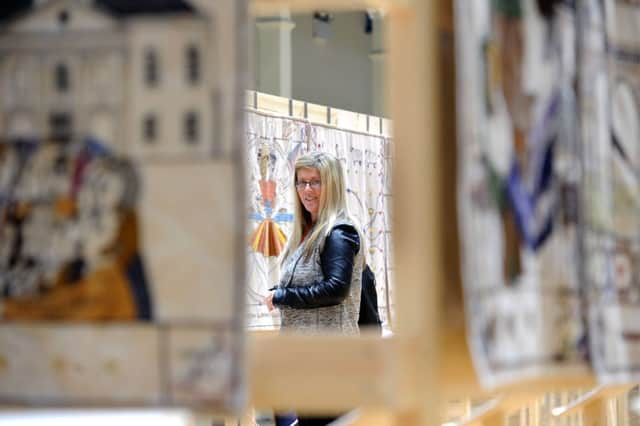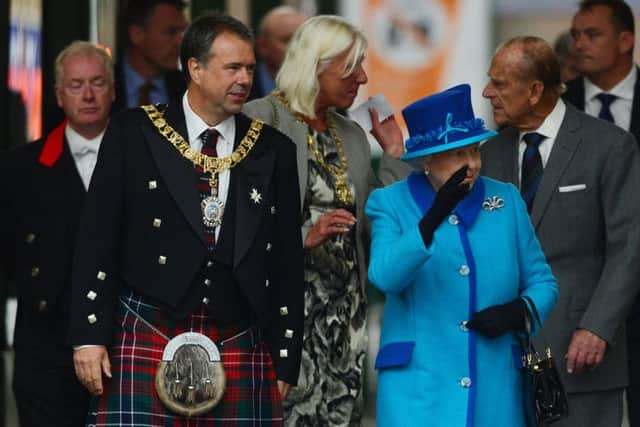James Naughtie: Tapestry helps link past & present


THE journey made by the Queen on the Borders line yesterday was a glimpse into the future, but it also looked to the past. As well as the story of the railway itself – the closure in the 1960s, the campaign for its restoration, the laying of the new line – there were displays at both stations, and at Abbotsford near the terminus, of a stirring narrative, woven in brilliant colours, that will soon take its place deep in the Borders – The Great Tapestry of Scotland.
It was an appropriate backdrop to the journey for the longest-serving monarch, because the tapestry is another marker of our own sense of history: a modern account of Scotland, put together by a thousand hands, and turning the sweep of our national story into a notable piece of public art.
Advertisement
Hide AdAdvertisement
Hide AdThe completion of the line is also the beginning of the tapestry’s journey to its new home.


On the 160 panels, making it longer than Bayeux, the story of Scotland is brought to life in vivid colours and the people – scholars and crofters, fishermen and weavers, prelates and kings – seem to spring from the landscape, telling their own stories. More than 300,000 people have already looked at the tapestry on its travels around Scotland, and the plan is now for it to have a permanent home at Tweedbank, where the steam trains will come to a halt.
It’s a perfect setting. The woollen mills of the Borders were once one of the glories of Scotland and the yarn that roughly a thousand volunteer stitchers used in the panels – nearly 500,000 metres of it – is thread that connects everyone who looks at the tapestry with that past, just as the images created from Andrew Crummy’s inspired drawings and collages are a dazzling kaleidoscope of our history.
He took battles and turned them into meditations, illustrated great minds in a dozen ingenious ways, caught the flow of our landscape and the swell of the sea, and managed to make it seem as if the people who fought the Romans, then the first ploughmen, the soldiers going to the Somme, the shipbuilders on the Clyde, were indeed hewn from the same rock. Visitors have been overwhelmed by the sense of continuity in the story, as if it’s a tale told by one person through the course of one long night.
As one of its trustees, I’ve been struck by the force of the tapestry’s appeal, and the breadth of it. During the referendum campaign, when feelings were running high on both sides of the argument, the tapestry hung splendidly and still at the heart of it all and became a unifying piece of art rather than a cause for division. This was obvious to anyone who spoke to the crowds who came to see it, and remarkable.
The reason, surely, is that the depiction of Scotland’s story – from earliest times to today, through great events, social movements and notable people – is so rich and uplifting that anyone trying to put an ugly political frame on it would fail. Like any good piece of art, it takes us out of ourselves.
There are recurring, unifying motifs in the tapestry – curves and circles, for example, that seem to come from the sea and the stones, and which embrace the people in every era, from the Picts to contemporary Scots. The panels have fine, imaginative lines and colours of the kind that you might find in a huge window at the east end of one of the great cathedrals. In that sense, it already exudes a feeling of permanence, although the final stitches have yet to be added.
Above all, perhaps, it seems to embody the collective effort of the stitchers – groups who came together all over Scotland – who poured such energy into the task, stamping themselves on every panel. They met around kitchen tables and village halls, argued about the stitching and wondered about the right colours. How it came together was something of a little miracle, supervised by Dorie Wilkie, who turned Andrew’s art into stitches and organised the thousand hands who took up needle and thread. Something of that effort – the sheer commitment involved – has survived on the canvas.
Advertisement
Hide AdAdvertisement
Hide AdIt’s intimate and, in places, hypnotic. People who see the tapestry immediately feel themselves being drawn into the story, and that’s why so many have driven across Scotland to see it for a second or third time at the places where it’s been exhibited.
Everyone has a favourite panel, from David Hume and Jean-Jacques Rousseau together with their heads as books of learning, the shoals of herring or the Romans at Mons Graupius. It could be golf at St Andrews or Archie Gemmill’s goal, the Forth Bridge or the Scottish Parliament being reborn inside a great sprouting thistle. All Scotland’s there.
Alistair Moffat was the guiding hand in assembling the story – choosing the people and the events that could best tell our story – and the trick was then to let Andrew Crummy’s imagination take over.
How appropriate it is that the Borders will become its home, not just because it’s a part of Scotland where wool has been a way of life, but because just up the road is Abbotsford, where Walter Scott wrote his own life of Scotland, taking story and legend and weaving them into a majestic pattern. He was a magpie collector of artifacts from Scotland’s past, with which he stuffed his home, as if he was feeding his imagination each time he picked up an old sword, or a coin that was said to have been found on Culloden field, or touched a faded piece of cloth from days gone by.
Seeing the tapestry gives you the same kind of thrill, telling a story that you can almost touch, and that’s why so many people will take the Borders line to see it.